A Comparison Analysis of Four Different Drying Treatments on the Volatile Organic Compounds of Gardenia Flowers
Abstract
:1. Introduction
2. Results
2.1. The Influence of Different Drying Methods on the Appearance and Characteristics of Gardenia Flowers
2.2. GC–IMS Analysis of VOCs in the Five Groups of Gardenia Flowers
2.2.1. Comparison of VOCs in the Five Groups of Gardenia Flowers
2.2.2. Qualitative Analysis of VOCs in Groups of Gardenia Flowers by GC–IMS
2.2.3. GC–IMS Profile Analysis of VOCs in the Five Groups of Gardenia Flowers
2.3. Chemometric Analysis
2.3.1. Principal Component Analysis (PCA)
2.3.2. Cluster Analysis (CA)
2.3.3. Partial Least-Squares Discriminant Analysis (PLS-DA)
3. Discussion
4. Materials and Methods
4.1. Materials
4.2. Drying Procedures
4.3. Analysis by GC–IMS
4.4. Statistical Analysis
5. Conclusions
Author Contributions
Funding
Institutional Review Board Statement
Informed Consent Statement
Data Availability Statement
Conflicts of Interest
References
- Zhang, N.; Bian, Y.; Yao, L. Essential Oils of Gardenia jasminoides J. Ellis and Gardenia jasminoides f. longicarpa Z.W. Xie & M. Okada Flowers: Chemical Characterization and Assessment of Anti-Inflammatory Effects in Alveolar Macrophage. Pharmaceutics 2022, 14, 966. [Google Scholar] [CrossRef]
- Hou, Z.; Sun, L.; Jiang, Z.; Zeng, T.; Wu, P.; Huang, J.; Liu, H.; Xiao, P. Neuropharmacological insights into Gardenia jasminoides Ellis: Harnessing therapeutic potential for central nervous system disorders. Phytomed. Int. J. Phytother. Phytopharm. 2024, 125, 155374. [Google Scholar] [CrossRef]
- Zhang, N.; Luo, M.; He, L.; Yao, L. Chemical Composition of Essential Oil from Flower of ‘Shanzhizi’ (Gardenia jasminoides Ellis) and Involvement of Serotonergic System in Its Anxiolytic Effect. Molecules 2020, 25, 4702. [Google Scholar] [CrossRef]
- Hu, Y.; Fu, X.W.; Que, S.Q.; Luo, X.F.; Zhang, X.L.; Cheng, Y.Y.; Ni, Q.X. Effects of Drying and Extraction Methods on Components and Activities of Gardenia jasminoides Ellis Flower. Food Sci. Technol. 2024, 49, 200–207. [Google Scholar] [CrossRef]
- De Tollenaere, M.; Chapuis, E.; Martinez, J.; Paulus, C.; Dupont, J.; Don Simoni, E.; Robe, P.; Sennelier-Portet, B.; Auriol, D.; Scandolera, A.; et al. Gardenia jasminoides Extract, with a Melatonin-like Activity, Protects against Digital Stress and Reverses Signs of Aging. Int. J. Mol. Sci. 2023, 24, 4948. [Google Scholar] [CrossRef]
- Liu, H.; Zang, C.; Shang, J.; Zhang, Z.; Wang, L.; Yang, H.; Sheng, C.; Yuan, F.; Ju, C.; Li, F.; et al. Gardenia jasminoides J. Ellis extract GJ-4 attenuates hyperlipidemic vascular dementia in rats via regulating PPAR-γ-mediated microglial polarization. Food Nutr. Res. 2022; available online. [Google Scholar] [CrossRef]
- Pyun, B.J.; Lee, J.Y.; Kim, Y.J.; Ji, K.Y.; Jung, D.H.; Park, K.S.; Jo, K.; Choi, S.; Jung, M.A.; Kim, Y.H.; et al. Gardenia jasminoides Attenuates Allergic Rhinitis-Induced Inflammation by Inhibiting Periostin Production. Pharmaceuticals 2021, 14, 986. [Google Scholar] [CrossRef]
- Ran, D.; Hong, W.; Yan, W.; Mengdie, W. Properties and molecular mechanisms underlying geniposide-mediated therapeutic effects in chronic inflammatory diseases. J. Ethnopharmacol. 2021, 273, 113958. [Google Scholar] [CrossRef]
- Xing, H.; Zhang, K.; Zhang, R.; Shi, H.; Bi, K.; Chen, X. Antidepressant-like effect of the water extract of the fixed combination of Gardenia jasminoides, Citrus aurantium and Magnolia officinalis in a rat model of chronic unpredictable mild stress. Phytomed. Int. J. Phytother. Phytopharm. 2015, 22, 1178–1185. [Google Scholar] [CrossRef]
- Wagan, T.A.; Cai, W.; Hua, H. Repellency, toxicity, and anti-oviposition of essential oil of Gardenia jasminoides and its four major chemical components against whiteflies and mites. Sci. Rep. 2018, 8, 9375. [Google Scholar] [CrossRef]
- Feng, J.; Hao, L.; Zhu, H.; Li, M.; Liu, Y.; Duan, Q.; Jia, L.; Wang, D.; Wang, C. Combining with volatilomic profiling and chemometrics to explore the volatile characteristics in five different dried Zanthoxylum bungeanum maxim. Food Res. Int. 2024, 175, 113719. [Google Scholar] [CrossRef]
- Hu, D.; Liu, X.; Qin, Y.; Yan, J.; Li, R.; Yang, Q. The impact of different drying methods on the physical properties, bioactive components, antioxidant capacity, volatile components and industrial application of coffee peel. Food Chem. X 2023, 19, 100807. [Google Scholar] [CrossRef]
- Fathi, F.; Ebrahimi, S.N.; Matos, L.C.; Oliveira, M.B.P.P.; Alves, R.C. Emerging drying techniques for food safety and quality: A review. Compr. Rev. Food Sci. Food Saf. 2022, 21, 1125–1160. [Google Scholar] [CrossRef]
- Suo, K.; Feng, Y.; Zhang, Y.; Yang, Z.; Zhou, C.; Chen, W.; Shi, L.; Yan, C. Comparative Evaluation of Quality Attributes of the Dried Cherry Blossom Subjected to Different Drying Techniques. Foods 2023, 13, 104. [Google Scholar] [CrossRef]
- Wang, Z.; Li, H.; Cao, W.; Chen, Z.; Gao, J.; Zheng, H.; Lin, H.; Qin, X. Effect of Drying Process on the Formation of the Characteristic Flavor of Oyster (Crassostrea hongkongensis). Foods 2023, 12, 2136. [Google Scholar] [CrossRef]
- Demircan, B.; Velioglu, Y.S.; Giuffrè, A.M. Comparison of different drying methods for bergamot peel: Chemical and physicochemical properties. J. Food Sci. 2024, 89, 1498–1516. [Google Scholar] [CrossRef]
- Sun, M.; Ni, L.; Huang, Y.; Yang, M.; Cheng, G.; Zhang, M.; Wu, M.; Ma, C. Effects of different drying treatments on the microstructure, free amino acids, volatile compounds and antioxidant activity of Flammulina velutipes root. Food Chem. X 2023, 18, 100656. [Google Scholar] [CrossRef]
- Baibuch, S.; Zema, P.; Bonifazi, E.; Cabrera, G.; Mondragón Portocarrero, A.D.C.; Campos, C.; Malec, L. Effect of the Drying Method and Optimization of Extraction on Antioxidant Activity and Phenolic of Rose Petals. Antioxidants 2023, 12, 681. [Google Scholar] [CrossRef]
- Ma, Y.; Yao, J.; Zhou, L.; Zhao, M.; Liu, J.; Marchioni, E. Characterization and discrimination of volatile organic compounds and lipid profiles of truffles under different treatments by UHPLC-QE Orbitrap/MS/MS and P&T-GC-MS. Food Chem. 2023, 410, 135432. [Google Scholar] [CrossRef]
- Li, X.; Zhang, Y.; Hengchao, E.; He, X.; Li, J.; Zhao, X.; Zhou, C. Characteristic fingerprints and comparison of volatile flavor compounds in Morchella sextelata under different drying methods. Food Res. Int. 2023, 172, 113103. [Google Scholar] [CrossRef]
- Gao, Y.D.; Hu, N.; Wang, H.L. Effect of different drying methods on volatile components in Lycium barbarum fruits from Qaidam based on GC-IMS. Nat. Prod. Res. Dev. 2022, 34, 1989–1998, 2033. [Google Scholar] [CrossRef]
- Wang, C.; Zhang, Z.; Zhang, X.; Tian, X.; Chen, K.; Zeng, X. Characterization of Volatile Compounds by HS-GC-IMS and Chemical Composition Analysis of Colored Highland Barley Roasted at Different Temperatures. Foods 2022, 11, 2921. [Google Scholar] [CrossRef]
- Xu, L.; Wang, J.; Tian, A.; Wang, S.; Zhao, K.; Zhang, R.; Wu, X.; Liu, Y.; Liu, X.; Chen, K.; et al. Characteristic volatiles fingerprints in olive vegetable stored at different conditions by HS-GC-IMS. Food Chem. X 2023, 18, 100707. [Google Scholar] [CrossRef]
- Liu, Q. The Preparation of Gardeniae Flos and Aurantii Flos Capsules and Their Pharmacodynamics in the Treatment of Sleep Disorder Alzheimer’s Disease. Unpublished Master’s Thesis, Jiangxi University of Traditional Chinese Medicine, Nanchang, China, 2021. [Google Scholar] [CrossRef]
- Zhang, H. Inhibition of Yellowing of Broccoli by Trans-2-hexenal and Preparation of Fresh-keeping Products. Unpublished Master’s Thesis, Shandong Agricultural University, Taian, China, 2023. [Google Scholar] [CrossRef]
- Ma, W.; Zhao, L.; Johnson, E.T.; Xie, Y.; Zhang, M. Natural food flavour (E)-2-hexenal, a potential antifungal agent, induces mitochondria-mediated apoptosis in Aspergillus flavus conidia via a ROS-dependent pathway. Int. J. Food Microbiol. 2022, 370, 109633. [Google Scholar] [CrossRef]
- Ma, W.; Zhao, L.; Zhao, W.; Xie, Y. (E)-2-Hexenal, as a Potential Natural Antifungal Compound, Inhibits Aspergillus flavus Spore Germination by Disrupting Mitochondrial Energy Metabolism. J. Agric. Food Chem. 2019, 67, 1138–1145. [Google Scholar] [CrossRef]
- Vallianou, I.; Hadzopoulou-Cladaras, M. Camphene, a Plant Derived MonoterpenE,Exerts Its Hypolipidemic Action by Affecting SREBP-1 and MTP Expression. PLoS ONE 2016, 11, e0147117. [Google Scholar] [CrossRef]
- Afzal, M.I.; Ariceaga, C.C.; Boulahya, K.A.; Jacquot, M.; Delaunay, S.; Cailliez-Grimal, C. Biosynthesis and role of 3-methylbutanal in cheese by lactic acid bacteria: Major metabolic pathways, enzymes involved, and strategies for control. Crit. Rev. Food Sci. Nutr. 2017, 57, 399–406. [Google Scholar] [CrossRef]
- Feron, V.J.; Til, H.P.; de Vrijer, F.; Woutersen, R.A.; Cassee, F.R.; van Bladeren, P.J. Aldehydes: Occurrence, carcinogenic potential, mechanism of action and risk assessment. Mutat. Res. 1991, 259, 363–385. [Google Scholar] [CrossRef]
- Mishra, S.; Sanwal, N.; Sharma, N.; Sahu, J.K. Multivariate analysis of chemometric based aroma dynamics in small cardamom (Elettaria cardamomum Maton) during drying. J. Food Sci. Technol. 2022, 59, 4761–4771. [Google Scholar] [CrossRef]
- Ringnér, M. What is principal component analysis? Nat. Biotechnol. 2008, 26, 303–304. [Google Scholar] [CrossRef]
- Qin, Y.D.; Fang, F.M.; Wang, R.B.; Zhou, J.J.; Li, L.H. Differentiation between wild and artificial cultivated Stephaniae tetrandrae radix using chromatographic and flow-injection mass spectrometric fingerprints with the aid of principal component analysis. Food Sci. Nutr. 2020, 8, 4223–4231. [Google Scholar] [CrossRef]
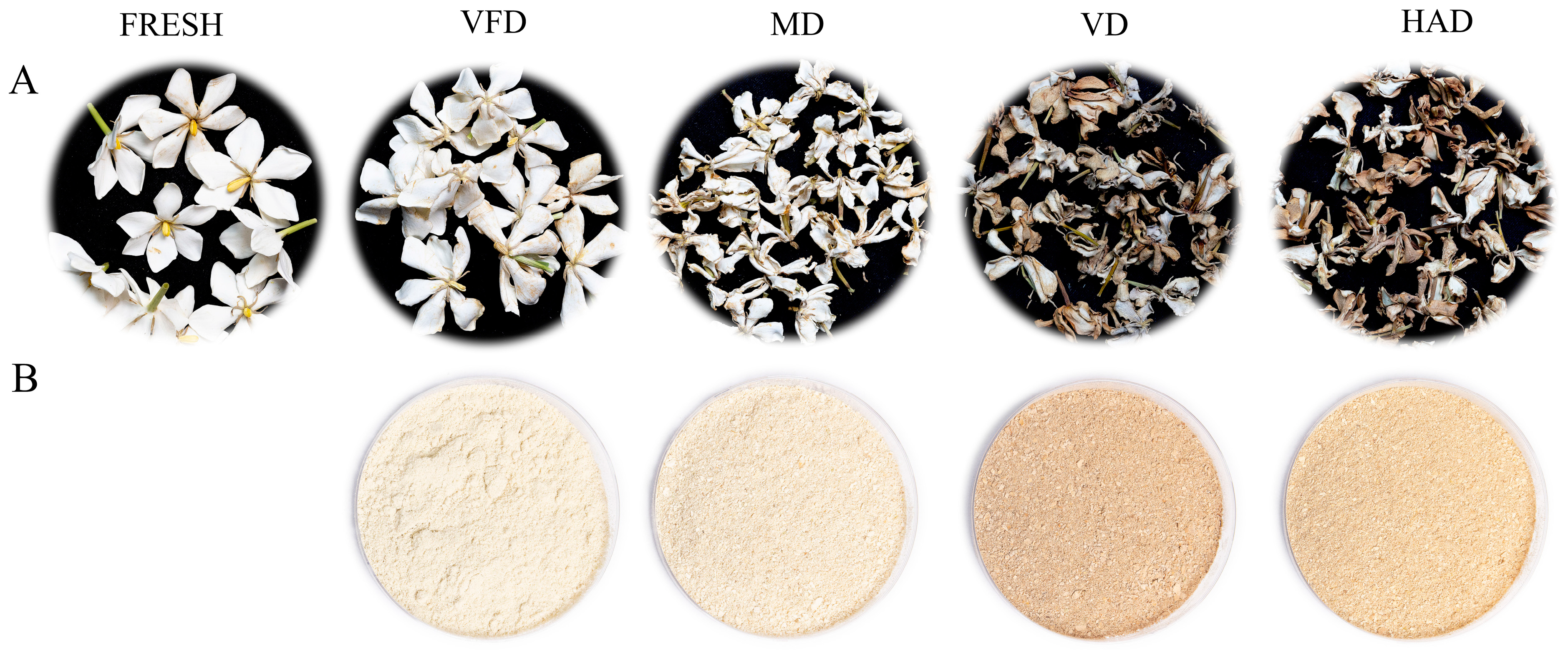
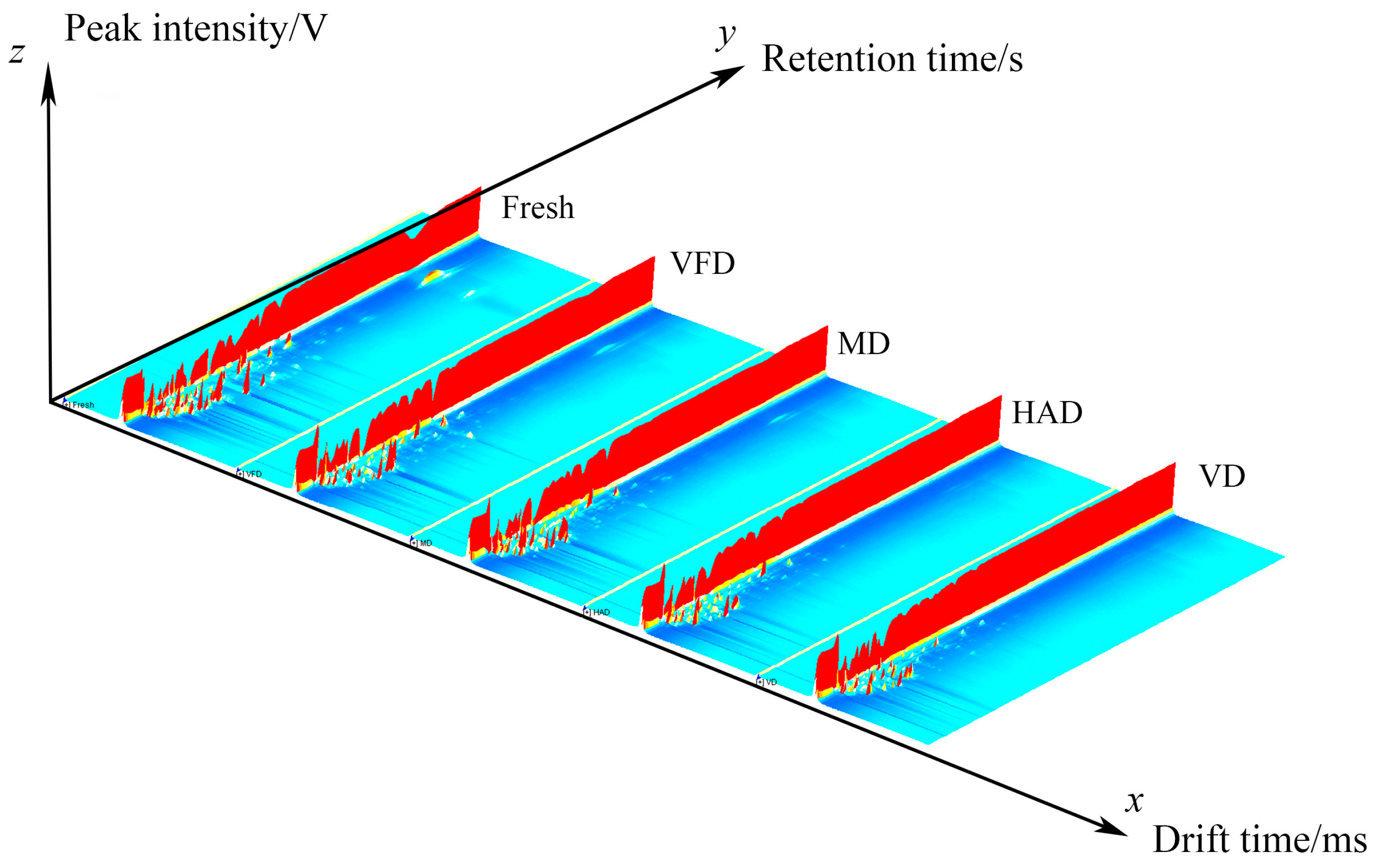
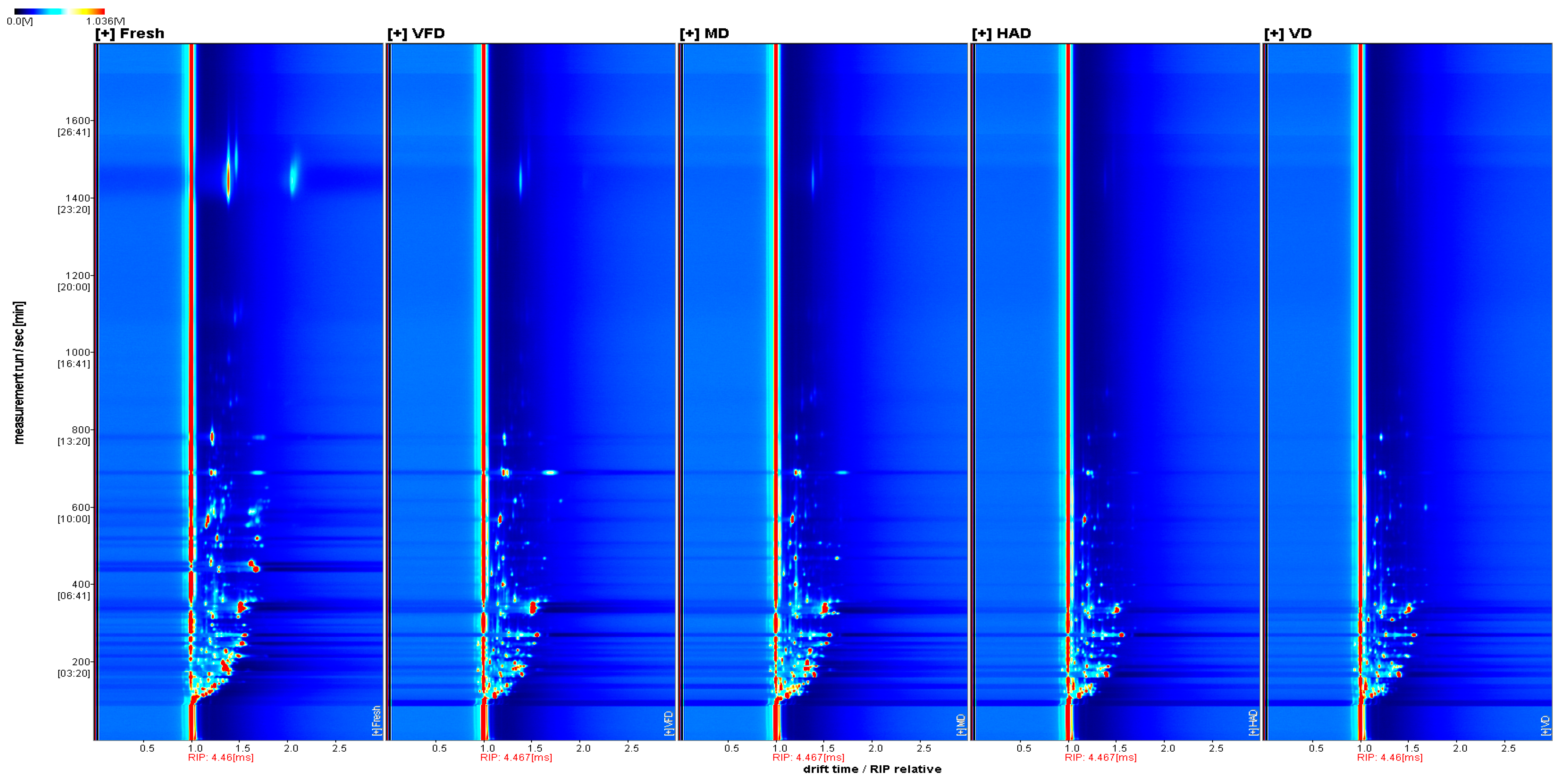
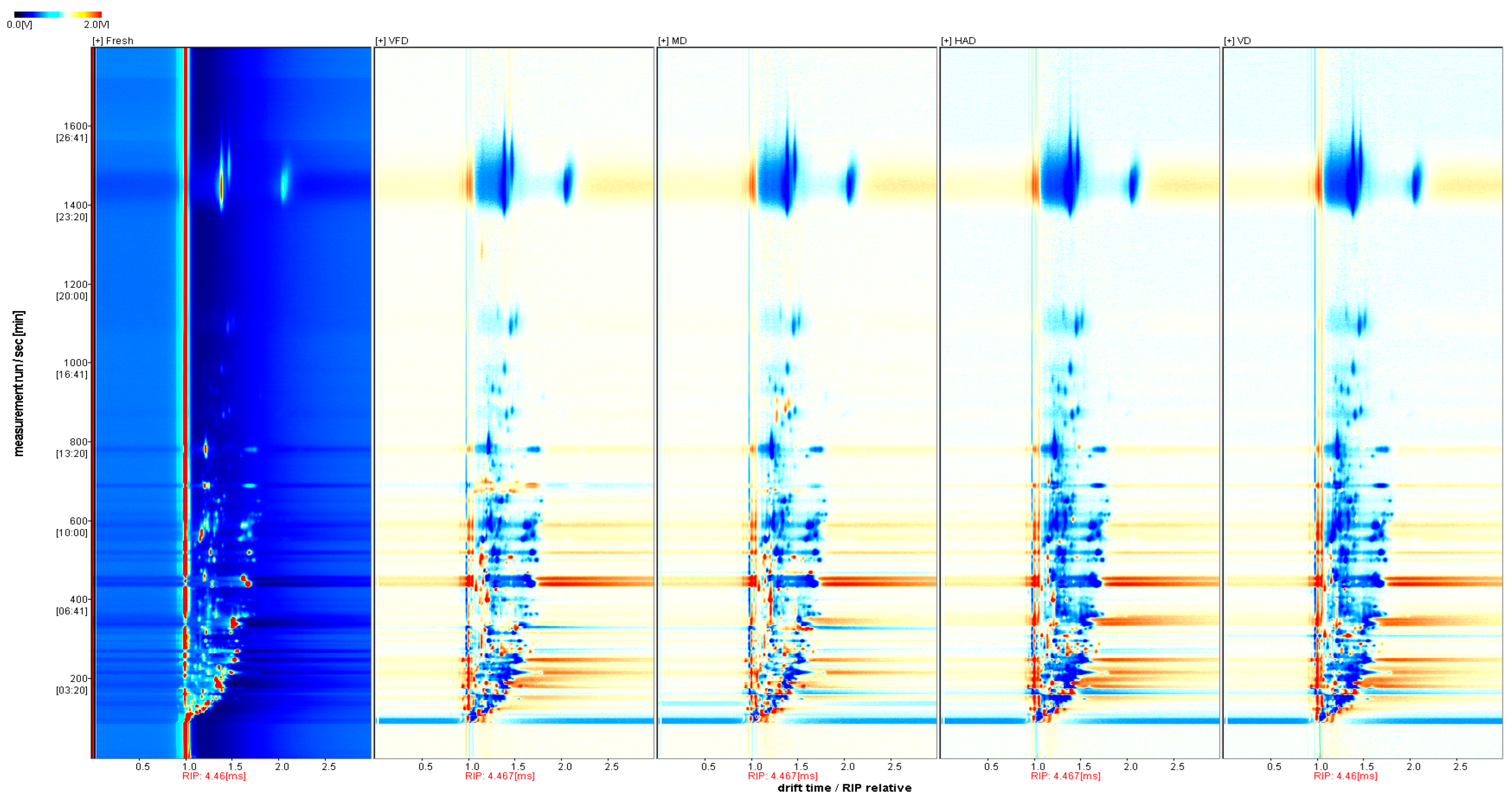
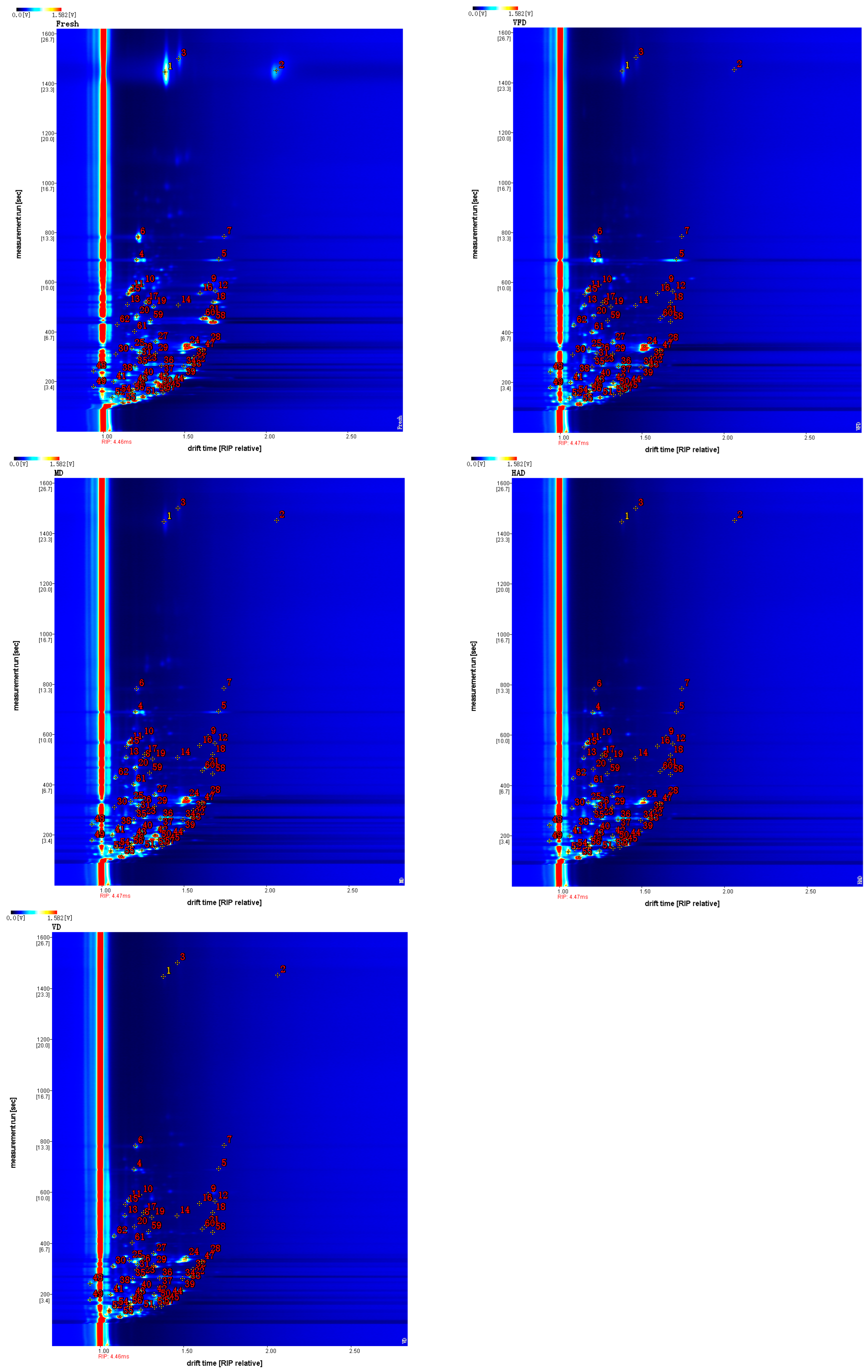
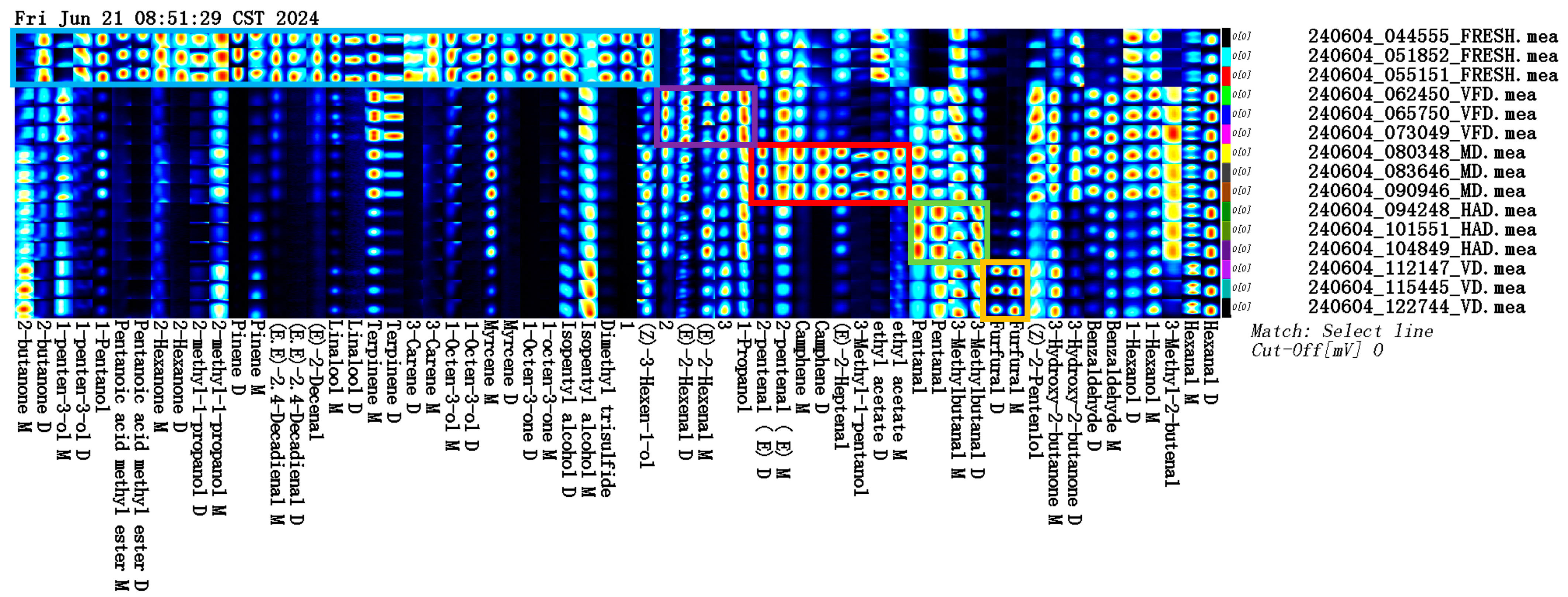





| No | Compounds | CAS# | Molecular Formula- | MW | RI | Rt/s | Dt/ms |
|---|---|---|---|---|---|---|---|
| 1 | (E,E)-2,4-Decadienal M | C25152845 | C10H16O | 152.2 | 1307.9 | 1446.213 | 1.38142 |
| 2 | (E,E)-2,4-Decadienal D | C25152845 | C10H16O | 152.2 | 1309.0 | 1450.998 | 2.06720 |
| 3 | (E)-2-Decenal | C3913813 | C10H18O | 154.3 | 1320.2 | 1500.447 | 1.46749 |
| 4 | Terpinene M | C99854 | C10H16 | 136.2 | 1059.1 | 690.082 | 1.20729 |
| 5 | Terpinene D | C99854 | C10H16 | 136.2 | 1060.2 | 692.312 | 1.71423 |
| 6 | Linalool M | C78706 | C10H18O | 154.3 | 1100.9 | 781.484 | 1.21490 |
| 7 | Linalool D | C78706 | C10H18O | 154.3 | 1101.9 | 783.713 | 1.74465 |
| 8 | (E)-2-Heptenal | C18829555 | C7H12O | 112.2 | 960.6 | 499.773 | 1.25167 |
| 9 | 3-Carene D | C13466789 | C10H16 | 136.2 | 1006.8 | 590.694 | 1.64996 |
| 10 | 3-Carene M | C13466789 | C10H16 | 136.2 | 1006.5 | 590.103 | 1.24163 |
| 11 | Myrcene M | C123353 | C10H16 | 136.2 | 995.5 | 570.620 | 1.17301 |
| 12 | Myrcene D | C123353 | C10H16 | 136.2 | 992.7 | 564.716 | 1.69179 |
| 13 | Benzaldehyde M | C100527 | C7H6O | 106.1 | 965.5 | 509.220 | 1.15293 |
| 14 | Benzaldehyde D | C100527 | C7H6O | 106.1 | 964.6 | 507.448 | 1.46420 |
| 15 | 1-Octen-3-ol M | C3391864 | C8H16O | 128.2 | 986.9 | 552.318 | 1.15460 |
| 16 | 1-Octen-3-ol D | C3391864 | C8H16O | 128.2 | 988.6 | 555.861 | 1.59808 |
| 17 | 1-Octen-3-one M | C4312996 | C8H14O | 126.2 | 970.9 | 519.847 | 1.26505 |
| 18 | 1-Octen-3-one D | C4312996 | C8H14O | 126.2 | 970.6 | 519.256 | 1.67673 |
| 19 | Dimethyl trisulfide | C3658808 | C2H6S3 | 126.3 | 961.7 | 501.977 | 1.31297 |
| 20 | Camphene M | C79925 | C10H16 | 136.2 | 940.8 | 463.618 | 1.20876 |
| 21 | Camphene D | C79925 | C10H16 | 136.2 | 944.4 | 469.967 | 1.63800 |
| 22 | Hexanal D | C66251 | C6H12O | 100.2 | 793.9 | 267.873 | 1.55140 |
| 23 | Hexanal M | C66251 | C6H12O | 100.2 | 798.5 | 272.432 | 1.25581 |
| 24 | (E)-2-Hexenal D | C6728263 | C6H10O | 98.1 | 861.3 | 343.782 | 1.51926 |
| 25 | (E)-2-Hexenal M | C6728263 | C6H10O | 98.1 | 852.9 | 333.232 | 1.17816 |
| 26 | (Z)-3-Hexen-1-ol | C928961 | C6H12O | 100.2 | 839.5 | 317.176 | 1.22790 |
| 27 | 1-Hexanol M | C111273 | C6H14O | 102.2 | 873.1 | 359.193 | 1.32284 |
| 28 | 1-Hexanol D | C111273 | C6H14O | 102.2 | 871.4 | 356.958 | 1.64838 |
| 29 | Furfural D | C98011 | C5H4O2 | 96.1 | 835.6 | 312.543 | 1.32538 |
| 30 | Furfural M | C98011 | C5H4O2 | 96.1 | 833.6 | 310.308 | 1.08091 |
| 31 | Pentanoic acid methyl ester M | C624248 | C6H12O2 | 116.2 | 820.9 | 296.062 | 1.22278 |
| 32 | Pentanoic acid methyl ester D | C624248 | C6H12O2 | 116.2 | 822.2 | 297.458 | 1.55971 |
| 33 | 1-Pentanol | C71410 | C5H12O | 88.1 | 774.5 | 248.573 | 1.52931 |
| 34 | 2-Hexanone D | C591786 | C6H12O | 100.2 | 786.8 | 260.865 | 1.49764 |
| 35 | 2-Hexanone M | C591786 | C6H12O | 100.2 | 786.2 | 260.306 | 1.19744 |
| 36 | 3-Methyl-2-butenal | C107868 | C5H8O | 84.1 | 788.5 | 262.541 | 1.35958 |
| 37 | 2-Pentenal (E) D | C1576870 | C5H8O | 84.1 | 753.4 | 228.461 | 1.35958 |
| 38 | 2-Pentenal (E) M | C1576870 | C5H8O | 84.1 | 757.4 | 232.092 | 1.10624 |
| 39 | Isopentyl alcohol D | C123513 | C5H12O | 88.1 | 739.6 | 216.170 | 1.49511 |
| 40 | Isopentyl alcohol M | C123513 | C5H12O | 88.1 | 737.0 | 213.935 | 1.23418 |
| 41 | 3-Hydroxy-2-butanone M | C513860 | C4H8O2 | 88.1 | 719.1 | 199.130 | 1.06697 |
| 42 | 3-Hydroxy-2-butanone D | C513860 | C4H8O2 | 88.1 | 718.0 | 198.292 | 1.32791 |
| 43 | Pentanal M | C110623 | C5H10O | 86.1 | 706.1 | 189.074 | 1.19744 |
| 44 | Pentanal D | C110623 | C5H10O | 86.1 | 705.4 | 188.515 | 1.41911 |
| 45 | 3-Methylbutanal D | C590863 | C5H10O | 86.1 | 671.6 | 166.726 | 1.40011 |
| 46 | 3-Methylbutanal M | C590863 | C5H10O | 86.1 | 669.0 | 165.330 | 1.18351 |
| 47 | 3-Methyl-1-pentanol | C589355 | C6H14O | 102.2 | 847.8 | 327.069 | 1.61165 |
| 48 | (Z)-2-Penten1ol | C1576950 | C5H10O | 86.1 | 768.0 | 242.149 | 0.94284 |
| 49 | 1-Penten-3-ol M | C616251 | C5H10O | 86.1 | 691.7 | 178.459 | 0.94284 |
| 50 | 1-Penten-3-ol D | C616251 | C5H10O | 86.1 | 695.6 | 181.252 | 1.34818 |
| 51 | 2-Butanone D | C78933 | C4H8O | 72.1 | 614.2 | 138.249 | 1.24753 |
| 52 | 2-Butanone M | C78933 | C4H8O | 72.1 | 608.5 | 135.712 | 1.05940 |
| 53 | Ethyl acetate D | C141786 | C4H8O2 | 88.1 | 638.2 | 149.516 | 1.33044 |
| 54 | Ethyl acetate M | C141786 | C4H8O2 | 88.1 | 634.1 | 147.529 | 1.09712 |
| 55 | 1-Propanol | C71238 | C3H8O | 60.1 | 553.1 | 113.251 | 1.12415 |
| 56 | 2-Methyl-1-propanol M | C78831 | C4H10O | 74.1 | 647.2 | 153.987 | 1.17910 |
| 57 | 2-Methyl-1-propanol D | C78831 | C4H10O | 74.1 | 646.2 | 153.490 | 1.37188 |
| 58 | Pinene D | C80568 | C10H16 | 136.2 | 928.2 | 441.947 | 1.67817 |
| 59 | Pinene M | C80568 | C10H16 | 136.2 | 931.0 | 446.754 | 1.29509 |
Disclaimer/Publisher’s Note: The statements, opinions and data contained in all publications are solely those of the individual author(s) and contributor(s) and not of MDPI and/or the editor(s). MDPI and/or the editor(s) disclaim responsibility for any injury to people or property resulting from any ideas, methods, instructions or products referred to in the content. |
© 2024 by the authors. Licensee MDPI, Basel, Switzerland. This article is an open access article distributed under the terms and conditions of the Creative Commons Attribution (CC BY) license (https://creativecommons.org/licenses/by/4.0/).
Share and Cite
Peng, J.; Ai, W.; Yin, X.; Huang, D.; Li, S. A Comparison Analysis of Four Different Drying Treatments on the Volatile Organic Compounds of Gardenia Flowers. Molecules 2024, 29, 4300. https://doi.org/10.3390/molecules29184300
Peng J, Ai W, Yin X, Huang D, Li S. A Comparison Analysis of Four Different Drying Treatments on the Volatile Organic Compounds of Gardenia Flowers. Molecules. 2024; 29(18):4300. https://doi.org/10.3390/molecules29184300
Chicago/Turabian StylePeng, Jiangli, Wen Ai, Xinyi Yin, Dan Huang, and Shunxiang Li. 2024. "A Comparison Analysis of Four Different Drying Treatments on the Volatile Organic Compounds of Gardenia Flowers" Molecules 29, no. 18: 4300. https://doi.org/10.3390/molecules29184300






